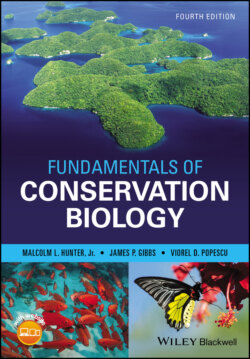Читать книгу Fundamentals of Conservation Biology - Malcolm L. Hunter Jr. - Страница 60
Recreation
ОглавлениеA person's requirements for food, clothing, shelter, tools, and fuel are fundamental, but we also have emotional needs that drive our search for well‐being. Virtually all of us find pleasure in interacting with other people, and most of us also seek enjoyment from our interactions with other living creatures. Enjoying another species does not necessarily require economic activity, but, in practice, our attraction to other species involves large sums of money (Fig. 3.8). Keeping pets and growing ornamental plants are the basis for enormous businesses. Dogs, cats, and roses may be a large part of this trade, but thousands of species from ants to zinnias are involved, and most of them are not domesticated.
Figure 3.8 People enjoy the diversity of nature in many ways. Some seek particular species; some just wish to enjoy a beautiful, peaceful environment; for some, nature inspires indoor hobbies.
(Matee Nusermn/Shutterstock, paseven/Shutterstock, wavebreakmedia/Shutterstock, Daniel Wilhelm Nilsson/Shutterstock, top to bottom, left to right)
The selling of encounters with wild plants and animals is part of a substantial enterprise known as nature tourism or ecotourism (Wearing and Schweinsberg 2018), a growing component of mass tourism, the largest industry on Earth. People pay to travel long distances for the privilege of seeing redwoods, coral reefs, whales, lions, and many other species. Most ecotourists carry expensive cameras and binoculars; some of them carry guns or fishing rods. Overall, hunters and anglers pay the highest sums to pursue their recreation, sometimes thousands of dollars per person per day. Closer to home, backyard interactions with wild creatures are the basis for large sales: sales of wild bird food, bird feeders, birdhouses, and birdbaths tally over $5 billion per year in the United States alone (US Fish and Wildlife Service 2018). In the home, hobbyists assemble collections of butterflies and mollusk shells, as well as books, paintings, sculptures, and stamps with flora and fauna themes.
Diversity is the spice of life, and species diversity is a key element in the recreational value of organisms. Many gardeners, exotic pet fanciers, and shell and butterfly collectors want to own species that their friends do not have, and they will pay handsomely for the privilege. Similarly, birders, botanizers, hunters, and anglers covet experiences with species they have not encountered before.
